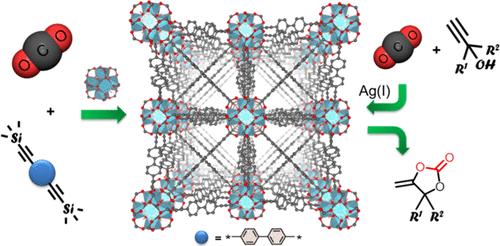当前位置:
X-MOL 学术
›
J. Am. Chem. Soc.
›
论文详情
Our official English website, www.x-mol.net, welcomes your feedback! (Note: you will need to create a separate account there.)
CO2-Based Stable Porous Metal–Organic Frameworks for CO2 Utilization
Journal of the American Chemical Society ( IF 15.0 ) Pub Date : 2024-05-10 , DOI: 10.1021/jacs.4c03476 Bo Song 1 , Yuhang Liang 2 , Yi Zhou 2 , Liang Zhang 3 , He Li 1 , Neng-Xiu Zhu 1 , Ben Zhong Tang 3, 4 , Dan Zhao 1 , Bin Liu 1
Journal of the American Chemical Society ( IF 15.0 ) Pub Date : 2024-05-10 , DOI: 10.1021/jacs.4c03476 Bo Song 1 , Yuhang Liang 2 , Yi Zhou 2 , Liang Zhang 3 , He Li 1 , Neng-Xiu Zhu 1 , Ben Zhong Tang 3, 4 , Dan Zhao 1 , Bin Liu 1
Affiliation

|
The transformation of carbon dioxide (CO2) into functional materials has garnered considerable worldwide interest. Metal–organic frameworks (MOFs), as a distinctive class of materials, have made great contributions to CO2 capture and conversion. However, facile conversion of CO2 to stable porous MOFs for CO2 utilization remains unexplored. Herein, we present a facile methodology of using CO2 to synthesize stable zirconium-based MOFs. Two zirconium-based MOFs CO2–Zr-DEP and CO2–Zr-DEDP with face-centered cubic topology were obtained via a sequential desilylation–carboxylation–coordination reaction. The MOFs exhibit excellent crystallinity, as verified through powder X-ray diffraction and high-resolution transmission electron microscopy analyses. They also have notable porosity with high surface area (SBET up to 3688 m2 g–1) and good CO2 adsorption capacity (up to 12.5 wt %). The resulting MOFs have abundant alkyne functional moieties, confirmed through 13C cross-polarization/magic angle spinning nuclear magnetic resonance and Fourier transform infrared spectra. Leveraging the catalytic prowess of Ag(I) in diverse CO2-involved reactions, we incorporated Ag(I) into zirconium-based MOFs, capitalizing on their interactions with carbon–carbon π-bonds of alkynes, thereby forming a heterogeneous catalyst. This catalyst demonstrates outstanding efficiency in catalyzing the conversion of CO2 and propargylic alcohols into cyclic carbonates, achieving >99% yield at room temperature and atmospheric pressure conditions. Thus, this work provides a dual CO2 utilization strategy, encompassing the synthesis of CO2-based MOFs (20–24 wt % from CO2) and their subsequent application in CO2 capture and conversion processes. This approach significantly enhances overall CO2 utilization.
中文翻译:

用于二氧化碳利用的二氧化碳基稳定多孔金属有机框架
将二氧化碳(CO 2)转化为功能材料已引起全世界的广泛关注。金属有机框架(MOF)作为一类独特的材料,为CO 2捕获和转化做出了巨大贡献。然而,将CO 2轻松转化为稳定的多孔MOF以利用CO 2仍有待探索。在此,我们提出了一种使用CO 2合成稳定的锆基MOF的简便方法。通过连续的脱甲硅烷基化-羧化-配位反应获得了两种具有面心立方拓扑结构的锆基MOFCO 2 –Zr-DEP和CO 2 –Zr-DEDP。通过粉末 X 射线衍射和高分辨率透射电子显微镜分析证实,MOF 表现出优异的结晶度。它们还具有显着的孔隙率、高表面积(S BET高达 3688 m 2 g –1)和良好的 CO 2吸附能力(高达 12.5 wt%)。通过13 C 交叉极化/魔角旋转核磁共振和傅里叶变换红外光谱证实,所得 MOF 具有丰富的炔功能部分。利用Ag(I)在多种涉及CO 2的反应中的催化能力,我们将Ag(I)引入到锆基MOF中,利用它们与炔烃碳-碳π键的相互作用,从而形成多相催化剂。该催化剂在催化CO 2和炔丙醇转化为环状碳酸酯方面表现出出色的效率,在室温和大气压条件下实现>99%的产率。因此,这项工作提供了一种双重CO 2利用策略,包括合成基于CO 2的MOF(20-24 wt% 来自CO 2)及其随后在CO 2捕获和转化过程中的应用。该方法显着提高了CO 2 的总体利用率。
更新日期:2024-05-10
中文翻译:

用于二氧化碳利用的二氧化碳基稳定多孔金属有机框架
将二氧化碳(CO 2)转化为功能材料已引起全世界的广泛关注。金属有机框架(MOF)作为一类独特的材料,为CO 2捕获和转化做出了巨大贡献。然而,将CO 2轻松转化为稳定的多孔MOF以利用CO 2仍有待探索。在此,我们提出了一种使用CO 2合成稳定的锆基MOF的简便方法。通过连续的脱甲硅烷基化-羧化-配位反应获得了两种具有面心立方拓扑结构的锆基MOFCO 2 –Zr-DEP和CO 2 –Zr-DEDP。通过粉末 X 射线衍射和高分辨率透射电子显微镜分析证实,MOF 表现出优异的结晶度。它们还具有显着的孔隙率、高表面积(S BET高达 3688 m 2 g –1)和良好的 CO 2吸附能力(高达 12.5 wt%)。通过13 C 交叉极化/魔角旋转核磁共振和傅里叶变换红外光谱证实,所得 MOF 具有丰富的炔功能部分。利用Ag(I)在多种涉及CO 2的反应中的催化能力,我们将Ag(I)引入到锆基MOF中,利用它们与炔烃碳-碳π键的相互作用,从而形成多相催化剂。该催化剂在催化CO 2和炔丙醇转化为环状碳酸酯方面表现出出色的效率,在室温和大气压条件下实现>99%的产率。因此,这项工作提供了一种双重CO 2利用策略,包括合成基于CO 2的MOF(20-24 wt% 来自CO 2)及其随后在CO 2捕获和转化过程中的应用。该方法显着提高了CO 2 的总体利用率。






























 京公网安备 11010802027423号
京公网安备 11010802027423号